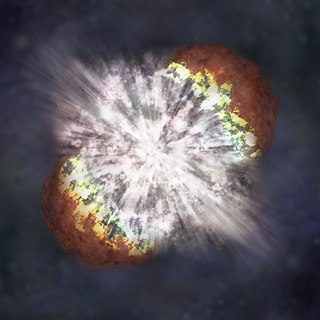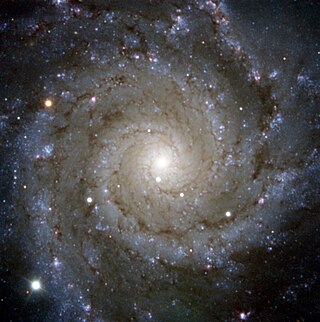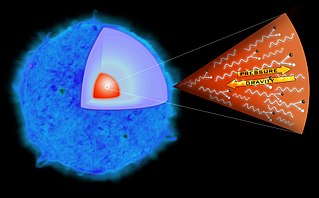Related Research Articles

A supernova is a powerful and luminous explosion of a star. A supernova occurs during the last evolutionary stages of a massive star or when a white dwarf is triggered into runaway nuclear fusion. The original object, called the progenitor, either collapses to a neutron star or black hole, or is completely destroyed to form a diffuse nebula. The peak optical luminosity of a supernova can be comparable to that of an entire galaxy before fading over several weeks or months.

A super-luminous supernova is a type of stellar explosion with a luminosity 10 or more times higher than that of standard supernovae. Like supernovae, SLSNe seem to be produced by several mechanisms, which is readily revealed by their light-curves and spectra. There are multiple models for what conditions may produce an SLSN, including core collapse in particularly massive stars, millisecond magnetars, interaction with circumstellar material, or pair-instability supernovae.

A blue supergiant (BSG) is a hot, luminous star, often referred to as an OB supergiant. They have luminosity class I and spectral class B9 or earlier.

Messier 74 is a large spiral galaxy in the equatorial constellation Pisces. It is about 32 million light-years away from Earth. The galaxy contains two clearly defined spiral arms and is therefore used as an archetypal example of a grand design spiral galaxy. The galaxy's low surface brightness makes it the most difficult Messier object for amateur astronomers to observe. Its relatively large angular size and the galaxy's face-on orientation make it an ideal object for professional astronomers who want to study spiral arm structure and spiral density waves. It is estimated that M74 hosts about 100 billion stars.

A Type Ia supernova is a type of supernova that occurs in binary systems in which one of the stars is a white dwarf. The other star can be anything from a giant star to an even smaller white dwarf.

Type Ib and Type Ic supernovae are categories of supernovae that are caused by the stellar core collapse of massive stars. These stars have shed or been stripped of their outer envelope of hydrogen, and, when compared to the spectrum of Type Ia supernovae, they lack the absorption line of silicon. Compared to Type Ib, Type Ic supernovae are hypothesized to have lost more of their initial envelope, including most of their helium. The two types are usually referred to as stripped core-collapse supernovae.

A Type II supernova or SNII results from the rapid collapse and violent explosion of a massive star. A star must have at least eight times, but no more than 40 to 50 times, the mass of the Sun (M☉) to undergo this type of explosion. Type II supernovae are distinguished from other types of supernovae by the presence of hydrogen in their spectra. They are usually observed in the spiral arms of galaxies and in H II regions, but not in elliptical galaxies; those are generally composed of older, low-mass stars, with few of the young, very massive stars necessary to cause a supernova.

SN 2006gy was an extremely energetic supernova, also referred to as a hypernova or quark-nova, that was discovered on September 18, 2006. It was first observed by Robert Quimby and P. Mondol, and then studied by several teams of astronomers using facilities that included the Chandra, Lick, and Keck Observatories. In May 2007 NASA and several of the astronomers announced the first detailed analyses of the supernova, describing it as the "brightest stellar explosion ever recorded". In October 2007 Quimby announced that SN 2005ap had broken SN 2006gy's record as the brightest-ever recorded supernova, and several subsequent discoveries are brighter still. Time magazine listed the discovery of SN 2006gy as third in its Top 10 Scientific Discoveries for 2007.

A pair-instability supernova is a type of supernova predicted to occur when pair production, the production of free electrons and positrons in the collision between atomic nuclei and energetic gamma rays, temporarily reduces the internal radiation pressure supporting a supermassive star's core against gravitational collapse. This pressure drop leads to a partial collapse, which in turn causes greatly accelerated burning in a runaway thermonuclear explosion, resulting in the star being blown completely apart without leaving a stellar remnant behind.

A luminous red nova is a stellar explosion thought to be caused by the merging of two stars. They are characterised by a distinct red colour, and a light curve that fades slowly with resurgent brightness in the infrared. Luminous red novae are not related to standard novae, which are explosions that occur on the surface of white dwarf stars.

SCP 06F6 is an astronomical object of unknown type, discovered on 21 February 2006 in the constellation Boötes during a survey of galaxy cluster CL 1432.5+3332.8 with the Hubble Space Telescope's Advanced Camera for Surveys Wide Field Channel.
SN 2005E was a calcium-rich supernova first observed in January 2005 that scientists concluded was a new type of cosmic explosion. The explosion originated in the galaxy NGC 1032, approximately 100 million light years away.

NGC 5806 is an intermediate spiral galaxy in the constellation Virgo. It was discovered on February 24, 1786, by the astronomer John Herschel. It is located about 70 million light-years away from the Milky Way. It is a member of the NGC 5846 Group.

SN 2014J was a type-Ia supernova in Messier 82 discovered in mid-January 2014. It was the closest type-Ia supernova discovered for 42 years, and no subsequent supernova has been closer as of 2023. The supernova was discovered by chance during an undergraduate teaching session at the University of London Observatory. It peaked on 31 January 2014, reaching an apparent magnitude of 10.5. SN 2014J was the subject of an intense observing campaign by professional astronomers and was bright enough to be seen by amateur astronomers.
iPTF14atg is a type-Ia supernova discovered on 3 May 2015. The supernova is located in galaxy IC 831, some 300 Mly (92 Mpc) distant. The supernova is thought to have ignited on May 2 or 3. The supernova's shockwave slammed into a companion star, shocking it into producing an ultraviolet pulse. The companion star that was hit is suspected to be a red giant star. This detection of the UV signal represents the first time the collision event of a supernova shockwave upon a companion star has been detected. The supernova was discovered by the Intermediate Palomar Transient Factory (iPTF), a successor to the earlier Palomar Transient Factory, and based at the Palomar Observatory in California. The data was processed by collaborators in Europe, that lead to the supernova discovery.

A hypernova is a very energetic supernova thought to result from an extreme core-collapse scenario. In this case, a massive star collapses to form a rotating black hole emitting twin astrophysical jets and surrounded by an accretion disk. It is a type of stellar explosion that ejects material with an unusually high kinetic energy, an order of magnitude higher than most supernovae, with a luminosity at least 10 times greater. They usually appear similar to a type Ic supernova, but with unusually broad spectral lines indicating an extremely high expansion velocity. Hypernovae are one of the mechanisms for producing long gamma ray bursts (GRBs), which range from 2 seconds to over a minute in duration. They have also been referred to as superluminous supernovae, though that classification also includes other types of extremely luminous stellar explosions that have different origins.
SN 2013fs is a supernova, located in the spiral galaxy NGC 7610, discovered by the Intermediate Palomar Transient Factory sky survey at Palomar Observatory in October 2013. It was discovered approximately three hours from explosion and was observed in ultraviolet and X-ray wavelengths, among others, within several hours. Optical spectra were obtained beginning at six hours from explosion, making these the earliest such detailed observations ever made of a supernova.

iPTF14hls is an unusual supernova star that erupted continuously for about 1,000 days beginning in September 2014 before becoming a remnant nebula. It had previously erupted in 1954. None of the theories nor proposed hypotheses fully explain all the aspects of the object.

NGC 5468 is an intermediate spiral galaxy located in the constellation Virgo. It is located at a distance of about 140 million light-years from Earth, which, given its apparent dimensions, means that NGC 5468 is about 110,000 light-years across. It was discovered by William Herschel on March 5, 1785.
Ken'ichi Nomoto is a Japanese astrophysicist and astronomer, known for his research on stellar evolution, supernovae, and the origin of heavy elements.
References
- ↑ "IAUC 8159: 2003gh; 2001co, 2003H, 2003dg,, 2003dr". www.cbat.eps.harvard.edu. Retrieved 2017-08-10.
- 1 2 Perets, H. B.; Gal-Yam, A.; Mazzali, P. A.; Arnett, D.; Kagan, D.; Filippenko, A. V.; Li, W.; Arcavi, I.; Cenko, S. B. (2010-05-20). "A faint type of supernova from a white dwarf with a helium-rich companion". Nature. 465 (7296): 322–325. arXiv: 0906.2003 . Bibcode:2010Natur.465..322P. doi:10.1038/nature09056. ISSN 0028-0836. PMID 20485429. S2CID 4368207.
- ↑ Brown, Eryn (2010-05-19). "Supernova is rich in calcium". Los Angeles Times. ISSN 0458-3035 . Retrieved 2017-08-10.
- ↑ Kasliwal, Mansi M.; Kulkarni, S. R.; Gal-Yam, Avishay; Nugent, Peter E.; Sullivan, Mark; Bildsten, Lars; Ofer Yaron; Perets, Hagai B.; Arcavi, Iair (2012). "Calcium-rich Gap Transients in the Remote Outskirts of Galaxies". The Astrophysical Journal. 755 (2): 161. arXiv: 1111.6109 . Bibcode:2012ApJ...755..161K. doi:10.1088/0004-637X/755/2/161. ISSN 0004-637X. S2CID 32808402.
- ↑ Smartt, Stephen J. (2009). "Progenitors of Core-Collapse Supernovae". Annual Review of Astronomy and Astrophysics. 47 (1): 63–106. arXiv: 0908.0700 . Bibcode:2009ARA&A..47...63S. doi:10.1146/annurev-astro-082708-101737. S2CID 55900386.
- ↑ Lyman, J. D.; Levan, A. J.; James, P. A.; Angus, C. R.; Church, R. P.; Davies, M. B.; Tanvir, N. R. (2016-05-11). "Hubble Space Telescopeobservations of the host galaxies and environments of calcium-rich supernovae". Monthly Notices of the Royal Astronomical Society. 458 (2): 1768–1777. arXiv: 1602.08098 . Bibcode:2016MNRAS.458.1768L. doi:10.1093/mnras/stw477. ISSN 0035-8711. S2CID 55274829.
- 1 2 Lunnan, R.; Kasliwal, M. M.; Cao, Y.; Hangard, L.; Yaron, O.; Parrent, J. T.; McCully, C.; Gal-Yam, A.; Mulchaey, J. S. (2017). "Two New Calcium-rich Gap Transients in Group and Cluster Environments". The Astrophysical Journal. 836 (1): 60. arXiv: 1612.00454 . Bibcode:2017ApJ...836...60L. doi: 10.3847/1538-4357/836/1/60 . S2CID 36667230.
- ↑ Lyman, J. D.; Levan, A. J.; Church, R. P.; Davies, M. B.; Tanvir, N. R. (2014-11-01). "The progenitors of calcium-rich transients are not formed in situ". Monthly Notices of the Royal Astronomical Society. 444 (3): 2157–2166. arXiv: 1408.1424 . Bibcode:2014MNRAS.444.2157L. doi:10.1093/mnras/stu1574. ISSN 0035-8711. S2CID 119196405.
- ↑ Parnell, Brid-Aine. "Lonely Supernovae May Have Been Kicked Out Of Their Galaxies". Forbes. Retrieved 2017-08-10.
- ↑ Foley, Ryan J. (2015-09-21). "Kinematics and host-galaxy properties suggest a nuclear origin for calcium-rich supernova progenitors". Monthly Notices of the Royal Astronomical Society. 452 (3): 2463–2478. arXiv: 1501.07607 . Bibcode:2015MNRAS.452.2463F. doi:10.1093/mnras/stv789. ISSN 0035-8711. S2CID 119261181.
- ↑ "HubbleSite: News – NASA's Hubble Finds Supernovae in 'Wrong Place at Wrong Time'". hubblesite.org. Retrieved 2017-08-10.
- ↑ Mulchaey, John S.; Kasliwal, Mansi M.; Kollmeier, Juna A. (2014). "Calcium-rich Gap Transients: Solving the Calcium Conundrum in the Intracluster Medium". The Astrophysical Journal Letters. 780 (2): L34. arXiv: 1401.7017 . Bibcode:2014ApJ...780L..34M. doi:10.1088/2041-8205/780/2/L34. ISSN 2041-8205. S2CID 118539574.
- ↑ Prentice, S. J.; Maguire, K.; Flörs, A.; Taubenberger, S.; Inserra, C.; Frohmaier, C.; Chen, T. W.; Anderson, J. P.; Ashall, C.; Clark, P.; Fraser, M.; Galbany, L.; Gal-Yam, A.; Gromadzki, M.; Gutiérrez, C. P.; James, P. A.; Jonker, P. G.; Kankare, E.; Leloudas, G.; Magee, M. R.; Mazzali, P. A.; Nicholl, M.; Pursiainen, M.; Skillen, K.; Smartt, S. J.; Smith, K. W.; Vogl, C.; Young, D. R. (2020). "The rise and fall of an extraordinary Ca-rich transient – The discovery of ATLAS19dqr/SN 2019bkc". Astronomy & Astrophysics. A186: 635. arXiv: 1909.05567 . Bibcode:2020A&A...635A.186P. doi:10.1051/0004-6361/201936515. S2CID 202565575.
- ↑ Perets, H. B.; Gal-Yam, A.; Mazzali, P. A.; Arnett, D.; Kagan, D.; Filippenko, A. V.; Li, W.; Arcavi, I.; Cenko, S. B.; Fox, D. B.; Leonard, D. C.; Moon, D.-S.; Sand, D. J.; Soderberg, A. M.; Anderson, J. P.; James, P. A.; Foley, R. J.; Ganeshalingam, M.; Ofek, E. O.; Bildsten, L.; Nelemans, G.; Shen, K. J.; Weinberg, N. N.; Metzger, B. D.; Piro, A. L.; Quataert, E.; Kiewe, M.; Poznanski, D. (2010). "A faint type of supernova from a white dwarf with a helium-rich companion". Nature. 465 (7296): 322–325. arXiv: 0906.2003 . Bibcode:2010Natur.465..322P. doi:10.1038/nature09056. PMID 20485429. S2CID 4368207.

